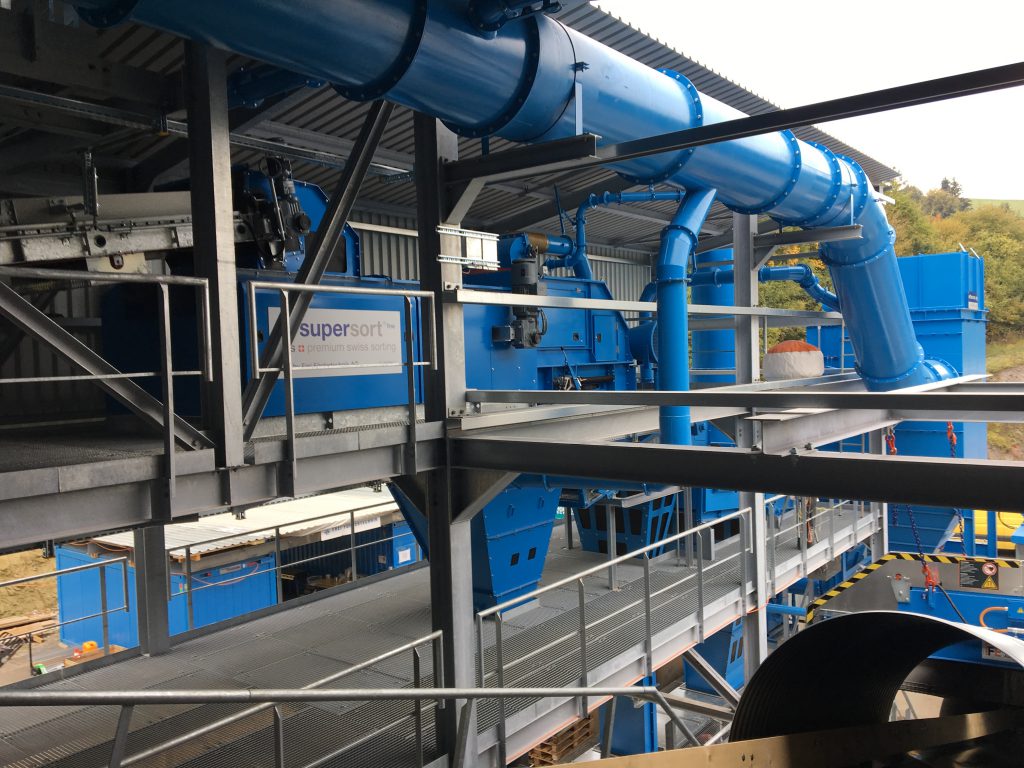
A steady trickle of fine particles (1-4 mm) of non-ferrous metals falls into the products box. Until recently, these valuable metals went straight to landfill directly and were lost. When it built a new bottom ash processing facility, KEWU AG decided to trust in DHZ AG’s supersort fine pss process and start recovering the fine metals too. This decision is clearly paying off. The system went into operation on schedule in cooperation with the plant manufacturer Frei Fördertechnik AG and its reliable operation and the increased metal yield from the fine bottom ash after incineration of municipal solid waste are impressive.
‘We want to recover as much metal as possible from the bottom ash with the new plant, particularly the fine particles,’ says Hans Buess, member of the management board at KEWU AG. ‘On the one hand, we want to reap the highest possible economic benefits and, on the other, we want to be prepared for any tightening of statutory limits in future.’
Already taken the next step
The plant manufacturer Frei Fördertechnik AG also accepted the tough challenge of guaranteeing a maximum non-ferrous metal content of 0.5% in the landfill bottom ash when it took on the order from KEWU AG. This target value corresponds to half the statutory requirement in Switzerland and it cannot be met unless the fine metals are recovered along with the rest.
This prompted KEWU AG and Frei Fördertechnik AG to use the supersort fine pss system. The new plant allows an economical and efficient recovery of fine metals. Initial measurements have shown that the requirements are being satisfied to the full.
Outstanding metal recovery
Classic screening technology for incineration of municipal solid waste(MSWI) bottom ash achieves a minimum screen cut of 3-4 mm. The screen mats tend to clog, particularly with moist material and the small perforations, thereby rending any classification impossible. Depending on the treatment process, the 1-4 mm fraction can account for around 50% of the total bottom ash.
However, experience has shown that the metal content in the fraction below 1 mm is low and its recovery both costly and complicated. So, to ensure effective metal recycling, it pays to separate the <1 mm fraction from the main 1-4 mm fraction.
This reduces the mass flow by up to 50% and produces a 1-4 mm fraction from which the metals can be efficiently recovered using eddy current separators. This in turn leads to a significant increase in recovery rates and reduces the amount of cleaning work necessary.
New method – more metals
Supersort fine pss was developed especially for the sorting of fine MSWI bottom ash that is difficult to screen. The engineering team at DHZ AG developed the patented follow-up model on the basis of its many years of experience in the treatment of bottom ash and the operation of the fine treatment plant at Lufingen near Zurich airport.
The use and combination of innovative technologies has made the recovery of fine metals even more reliable and efficient. The revised plant layout was realised in close cooperation with Frei Fördertechnik AG with special attention being paid to the ease of use and low maintenance costs.
The new layout not only makes the plant smaller, but also significantly improves sorting and operational reliability when processing bottom ash that is very moist. The innovative process exploits the differences in the distances travelled by accelerated particles of different sizes and densities to produce a fraction made up of coarser particles with a higher metal content.
This metal content is then increased further in an eddy current separator designed specifically for small grain sizes. The result is a valuable non-ferrous metal concentrate with a high share of light and heavy metals as well as a residue fraction largely depleted of metals.
Satisfied customer
The plant for KEWU AG, from the Bern region, is designed for an annual capacity of 70 000 tonnes of MSWI bottom ash and runs with a throughput of 45 tonnes per hour. To ensure effective metal recovery, the bottom ash is divided up into four grain-size fractions. Bottom ash particle sizes above 4 mm are treated with conventional screening technology. Material smaller than 4 mm is processed using supersort fine pss.
The system processes 22 tonnes per hour, nearly half the total mass flow. Despite a moisture content of over 18%, the ballistic method reliably separates the bottom ash into fine and coarse fractions. This cuts the mass flow in half and the metals are enriched in the coarse fraction. Thanks to this smaller mass flow, metals can be separated from the remaining 1-4 mm material using only an eddy current separator.
This not only improves the recovery rate for metals but also reduces the cleaning work. ‘We are highly delighted with the good planning and realisation by Frei Fördertechnik AG and DHZ AG as the supplier of the supersort fine pss system,’ says Hans Buess.
‘It’s great to see how even the smallest metal particles can be recovered thanks to fine processing. Especially if one remembers, that up to now, we lost all of these valuable metals to the landfill site,’ he concludes. This reinforces DHZ AG’s opinion that their supersort fine pss system is the ideal solution for other recycling companies interested in recovering metals from the fine fraction of their bottom ash.
